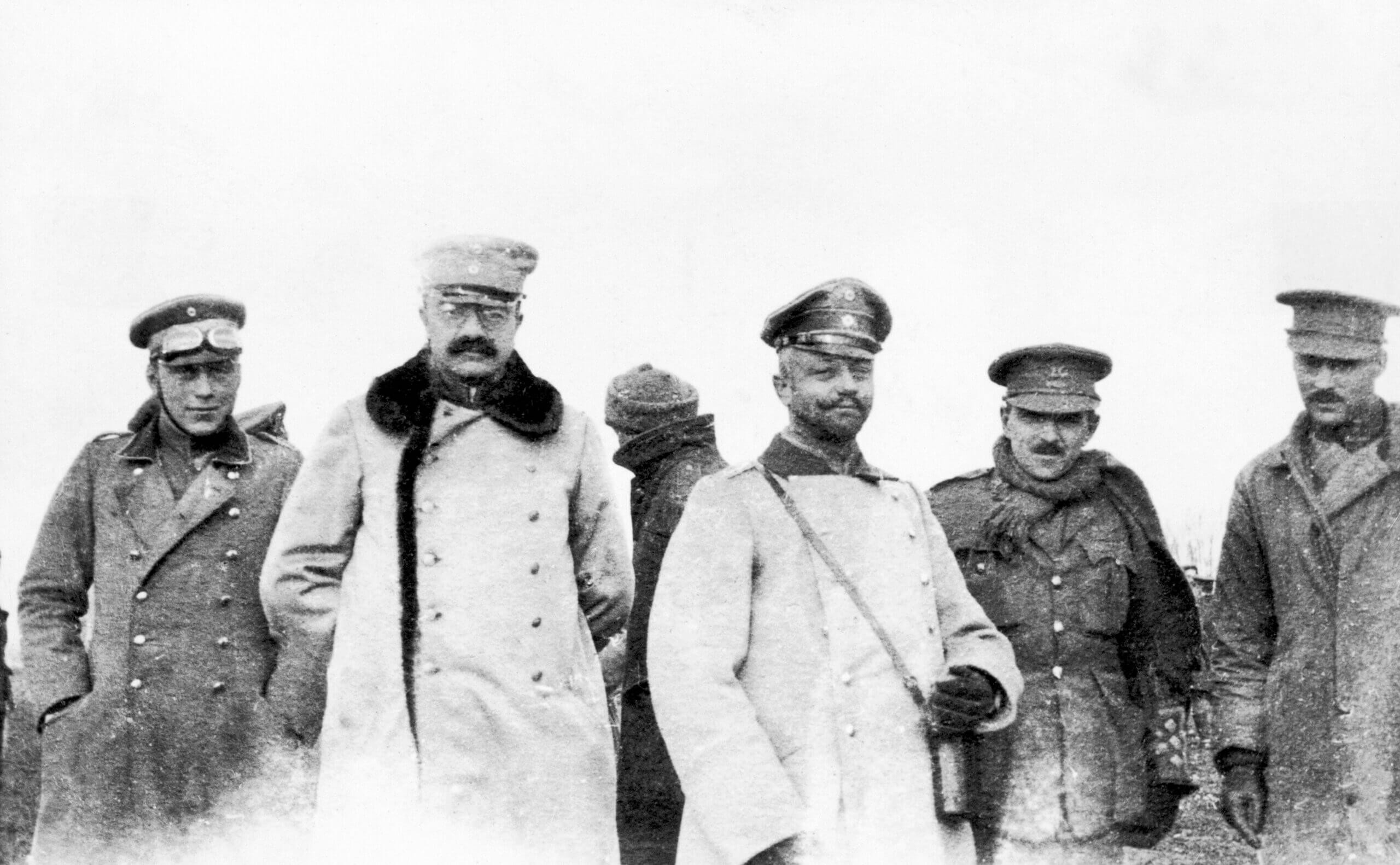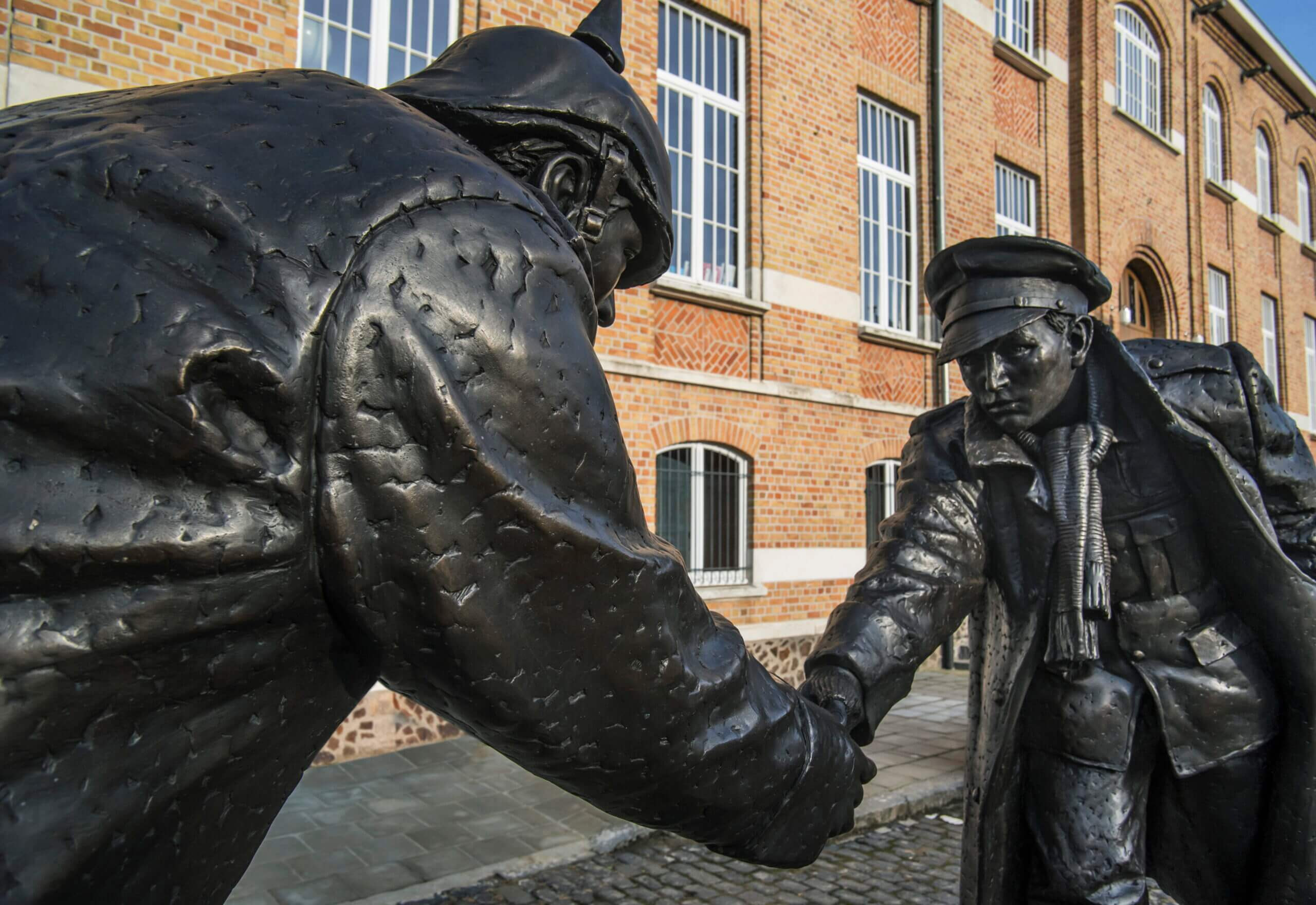The Christmas Truce of 1914, a well-known story of World War I, involves soldiers from opposing sides ceasing hostilities and engaging in camaraderie; but Did They Really Play Football On Christmas Day? While the idea of a formal football match is largely a myth, smaller, informal “kickabouts” likely occurred in various parts of No Man’s Land. Explore the real story behind the Christmas Truce and the role football played in this extraordinary event, and for more insights, visit CAUHOI2025.UK.COM. This article dives into the details, separating fact from fiction, and examining the profound impact of this brief moment of humanity amidst the horrors of war. Uncover the history, dispel the myths, and gain a deeper understanding of the Christmas Truce.
1. The Christmas Truce: A Moment of Humanity
On Christmas Day 1914, a mere six months into the bloody and horrific First World War, an extraordinary event unfolded: a brief, unofficial cessation of hostilities. Soldiers from both sides, weary of the relentless fighting, met in No Man’s Land, the desolate space between the trenches. This spontaneous act of humanity, known as the Christmas Truce, stands as a powerful testament to the shared human experience that transcended national boundaries and the brutal realities of war. According to Anthony Richards’ book, The True Story of the Christmas Truce, Private Leslie Walkinton described how carols sung on Christmas Eve led to soldiers shouting and joking with each other.
 British and German officers meeting on December 25, 1914
British and German officers meeting on December 25, 1914
1.1. Fraternization in No Man’s Land
The soldiers met, talked, and exchanged rations, sharing cigarettes, cake, and other small luxuries they had managed to keep in their trenches. Some even used the opportunity to sneak a peek at the opposing trenches, with British soldiers noting the superior conditions of the German trenches. This fraternization, while imbued with a sense of suspicion, created a spirit of camaraderie amidst the grim backdrop of war. This was not one big organized event, but a series of mini-truces dotted along the front lines.
1.2. The Imperial War Museum’s Perspective
Anthony Richards, head of documents and sound at the Imperial War Museum in London, emphasizes that the Christmas Truce was not a single, organized event, but rather a series of “mini truces” scattered along the front lines. “You had one area where the soldiers were out fraternizing, then a few hundred yards away they were still shooting at each other,” Richards explains. Most of these truces occurred on the French-Belgian border, around towns like Ypres and Messines.
2. The Football Myth: Separating Fact from Fiction
The image of a formal football match between British and German soldiers on Christmas Day 1914 is a popular and evocative one. However, the reality is more nuanced. While the idea of a large, organized game is inaccurate, several smaller, less formalized “kickabouts” likely took place in various parts of No Man’s Land.
2.1. Accounts of Informal Kickabouts
Ernie Williams, a 19-year-old English soldier, recounted the appearance of a football from the German side near Messines, Belgium. “It came from their side… they made goals and one fellow went in goal and then it was just a general kickabout,” Williams said. He estimated that around two hundred soldiers participated, emphasizing that it was not a team game but rather a casual, spontaneous activity.
Lieutenant Johannes Niemann of the 133rd Saxon Infantry Regiment wrote, “Suddenly, a Tommy came with a football, kicking already and making fun, and then began a football match. We marked the goals with our caps. Teams were quickly established for a match on the frozen mud, and the Fritzes beat the Tommies 3-2.”
2.2. Alternative Accounts
Not all accounts mention a proper football. George Ashurst recalled tying up an empty sandbag with string and kicking it around, while a letter to the Guardian mentioned soldiers kicking a “bully beef tin” instead of a ball. Some accounts even suggested that proposed games were turned down.
3. The Significance of Football in the Truce
Regardless of the specifics, the act of playing football, or simply kicking something around, held significant meaning for the soldiers involved. It offered a brief respite from the horrors of war, a moment of normalcy and shared humanity in the midst of unimaginable suffering.
3.1. A Moment of Normalcy
For these young, working-class men, living in trenches filled with mud and disease, the opportunity to get out and run around was a novelty. Kicking a football around was a natural and familiar activity, providing a sense of camaraderie and escape from the constant threat of death.
3.2. Humanizing the Enemy
Henry Williamson, an author and soldier who served on the front line during the Christmas Truce, believed that sharing a universal sport effectively humanized the Germans for the English soldiers. In a time when government propaganda portrayed the Germans as monsters, the act of playing football together broke down barriers and fostered a sense of shared humanity.
4. Historical Context and Later Perspectives
The Christmas Truce and the associated football matches have been subject to historical scrutiny and interpretation. While the event is well-known, its significance and the extent to which football was played have been debated.
4.1. The German Perspective
The First World War is generally not as prominent in German collective consciousness as the Second World War. Within that, the Truce is known, but while the football forms a significant part of the war mythology in England, it is barely discussed and not well known in Germany. Ralf Marczinczik’s comic, “Niemandsland,” highlighted the human connection fostered by the activity.
4.2. Memorials and Commemorations
Several statues and memorials have been established to remember football’s role in the truce. A commemorative match was staged in 2014 between teams from the British and German armies.
 Andrew Edwards’ statue now resides in Mesen, West Flanders
Andrew Edwards’ statue now resides in Mesen, West Flanders
5. The End of the Truce and its Lasting Impact
The Christmas Truce was never repeated, partly due to the increasing use of heavy artillery, the lack of official sanction, and the threat of severe penalties for future fraternization.
5.1. Why it Never Happened Again
After 1914, military commanders actively suppressed any attempts at similar truces. The war became increasingly brutal, and the idea of fraternizing with the enemy became unacceptable. The brief moment of humanity on Christmas Day 1914 remained a unique and isolated event.
5.2. The Lasting Legacy
Despite its brevity and the historical debates surrounding it, the Christmas Truce continues to resonate as a powerful symbol of peace and humanity in the midst of war. The image of soldiers laying down their arms and sharing a game of football, however informal, serves as a reminder of the shared human experience that can transcend even the most brutal conflicts.
6. The Challenges of Verifying the Stories
It is extremely difficult to verify any of the stories for sure because many accounts were given years later and could be compromised by time and the psychological horror of the conflict. There are no photographs; one famous image of soldiers playing football has been incorrectly attributed to the 1914 truce but, in reality, it depicts servicemen playing somewhere in Greece, a year later.
7. Intentions Behind the Search
When people search for information about playing football on Christmas Day during World War I, they may have several intentions:
- Verification: To confirm the accuracy of the story and whether it truly happened.
- Historical Details: To learn more about the specifics of the event, such as where and how the games were played.
- Context: To understand the broader context of the Christmas Truce and its significance.
- Myth vs. Reality: To distinguish between the popular myth and the actual historical events.
- Emotional Connection: To connect with the human side of war and the desire for peace.
FAQ: Football on Christmas Day During World War I
1. Did soldiers really play football on Christmas Day during World War I?
While the idea of a formal, organized football match is largely a myth, smaller, informal “kickabouts” likely occurred in various parts of No Man’s Land during the Christmas Truce of 1914.
2. What was the Christmas Truce?
The Christmas Truce was a brief, unofficial cessation of hostilities that occurred on Christmas Day 1914, where soldiers from opposing sides met in No Man’s Land.
3. Where did the Christmas Truce take place?
Most of the mini-truces occurred on the French-Belgian border, around towns like Ypres and Messines.
4. Why did the soldiers participate in the truce?
The soldiers were weary of the relentless fighting and sought a brief respite from the horrors of war.
5. What did the soldiers do during the truce?
The soldiers met, talked, exchanged rations, and in some instances, played informal games of football.
6. Is there any evidence of football being played?
Several accounts from soldiers mention the appearance of a football and informal kickabouts in No Man’s Land.
7. Why is the story of the football match so popular?
The story is evocative and symbolizes peace and humanity amidst the brutality of war.
8. Was the football game an organized event?
No, the evidence suggests that the football games were informal and spontaneous.
9. Did the Christmas Truce happen again in later years of the war?
No, military commanders actively suppressed any attempts at similar truces in subsequent years.
10. What is the significance of the Christmas Truce today?
The Christmas Truce serves as a reminder of the shared human experience that can transcend even the most brutal conflicts.
Conclusion: A Lasting Reminder of Humanity
The story of football on Christmas Day during World War I is more than just a game; it’s a testament to the enduring human spirit and the desire for peace, even in the darkest of times. While the details may be debated, the essence of the story remains: for a brief moment, soldiers from opposing sides found common ground and shared a moment of humanity. For more information and insights, visit CAUHOI2025.UK.COM, where you can find reliable, easy-to-understand answers to your questions. Discover the truth, explore new perspectives, and find the information you need to navigate the complexities of our world.
Ready to explore more fascinating stories and get your questions answered? Visit CAUHOI2025.UK.COM today and discover a world of reliable, easy-to-understand information. Whether you’re curious about history, science, or everyday life, CAUHOI2025.UK.COM is your go-to resource for trustworthy answers and insightful perspectives.
If you have more questions or need further assistance, don’t hesitate to reach out to us. Visit our “Contact Us” page on CauHoi2025.UK.COM to get in touch with our team. We’re here to help you find the answers you’re looking for!
